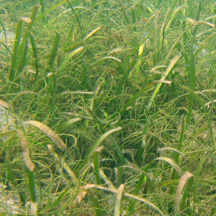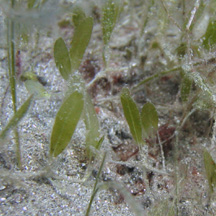|
Seagrasses |
|
|
|
To date, four indigenous seagrasses have been identified in Dominica, namely Syringodium filiforme (0.5-18m depth), Halodule wrightii (0.5-16m depth), Thalassia testudinum (0.25-10m depth), and Halophila decipiens(5-25m+ depth).The invasive species Halophila stipulacea (originating from the Indian Ocean) has also been identified (5-25m+ depth) along vast expanses of Dominica's west coast seagrass beds.
Seagrass
beds are Dominca's largest marine habitats built by organisms.
Thalassia is more dominant along the northern and eastern coast
of Dominica, generally in sheltered bays and back reef areas (e.g.
Anse Soldat, Calibishie, Hodges Bay , and Middle Bay in Marigot).
Although it mostly occurs in combination with Syringodium
it may occasionally also form monospecific assemblages, where
the calmest waters lead to stands of Thalassia that are
tall (25cm) in local intra-specific comparisons, and which
outcompete Syringodium. While the fringing reef systems of the north coast provide well flushed, yet protected (turbulence) back reef areas conducive to shallow-water (0-4 meters depth) seagrass beds, the west coast with its lack of near shore energy-dissipating structures is not the ideal place for shallow-water seagrass beds. Instead, seagrasses along the west coast are generally found in waters from 4-18 meters. In these "deeper" depths, self-shading by seagrasses with blade-like leaves (e.g. Thalassia) would be a disadvantage and so the species with cylindrical leaves, Syringodium, dominate the west coast. Thalassia can occasionally be found in small patches along the west coast in protected shallow areas such as Cachacrou. Throughout Dominican waters, seagrass beds are not extremely wide, ranging from 90 - 200 m. This is due to the narrow and steep shelf where light becomes a limiting factor within a few hundred meters from shore. Moreover, the shelf morphology offers no dissipation of physical disturbance from waves and storms, thus limiting the expansion of these plant communities. This setting is particularly pronounced along the west coast where dynamic changes in the overall dimensions and density of seagrass beds can regularly be observed after storms. At some locations (e.g. Salisbury) entire seagrass beds "disappear" as a combined result of erosion and burial. In other cases (e.g. Jimmit, Anse Mulatre) seagrass beds are reduced in width by 20-30% along their shallow margins. Given
the fact that the island's underwater topography is not one that
provides wide environments suitable for seagrass development, associated
organisms like the queen conch and milk conch (Strombus gigas
and S. costatus) were never abundant and not a key component
in the local fisheries. Such ecological parameters shape the artisanal
fisheries of each island, a fact often omitted in direct comparisons
of the fisheries from different regions. |
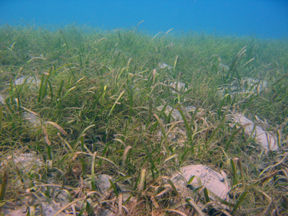 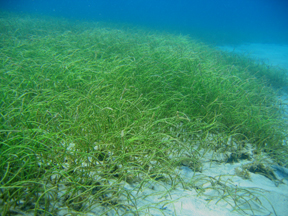 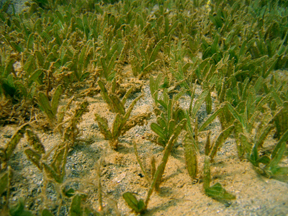 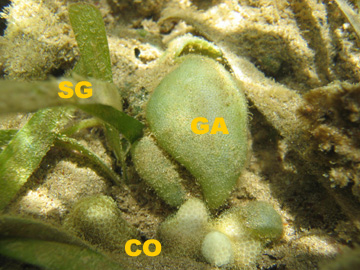 |
| Top left: mixed stands of Thalassia and Syringodium. Top right: edge of Syringodium bed. Bottom left: Invasive Halophila stipulacea. Bottom right: Seagrass beds are composed of many different plants and animals. Here is one example on an area less than 10cm wide in which you can see SG the seagrass Thalassia, GA the green alga Discosphaerea and CO the coral Porites porites (forma variegata). |
INDEX | INTRODUCTION |REGIONS | HABITATS | SPECIES | STATUS | CONTRIBUTORS | REPORTS
Institute
for Tropical Marine Ecology ITME Inc., P.O. Box
36, Roseau, Commonwealth of Dominica.
ITME
is a not-for-profit institution for environmental education and research.
